By P.V. Gopalakrishnan
A film’s narration is in the hands of its Director, besides its Editor & Cinematographer. While a Director’s role in filmmaking is second to none, he has to have teamwork with other functionaries. The Directors are the professionals who see every sequence shot through the eyes of the ultimate cine goer. They are like the captains of a ship and pilots of an aircraft.
These days, there is so much talent in the industry that we often witness the avtar of a new talent in film direction.
But think of the times when Cinema itself was in nascent stage & the Directors had the risk of experimenting with a pristine audience. In such a stage there were some outstanding Film Directors in Tamil Cinema who contributed to Tamil Cinema from its silent era, about whom we will talk here. We have excluded here the legend Ellis.R.Dungan, as we had covered in details about him earlier.
Sunder Rao Nadkarni
Sundar Rao Nadkarni, a Konkani from Mangalore, was an actor from Silent Film Era & later became an all rounder as editor, cinematographer, director and producer. He lived his formative years in Bombay which enabled him to delve deep into Marathi theatre and cinema. Thereon, Nadkarni moved to Coimbatore and finally Madras, where he settled down permanently. Inspired by the success of Sabapathy when AVM wanted to launch another comedy, he noted Nadkarni who went on to direct the Tamil Mega Hit film of AVM, En Manaivi (1942).
Following this success, Nadkarni also made other successful Tamil films. But his greatest hit was M.K.Thyagaraja Bhagavathar starred Haridas (1944), which set a record by becoming the first Tamil film to run for 110 weeks at the Broadway theatre in Madras.
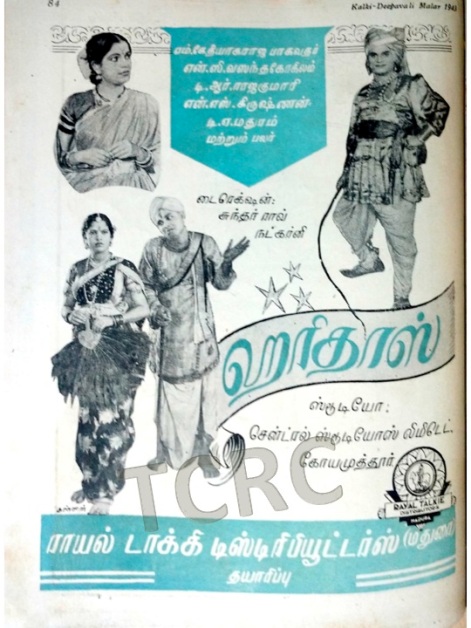
An ad for Haridas in Kalki Deepavali Malar 1943 PC: From the archives of TCRC
He directed all the top Tamil actors too during his active years, such as T. R. Rajakumari in Haridas (1944), Narsimha Bharathi in Krishna Vijayam (1950), and MGR and Savitri in Mahadevi (1957). (Nadkarni was the co-producer of ‘Mahadevi’).
Raja Sandow
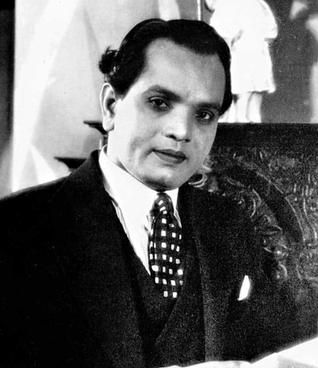
Raja Sandow PC: Unknown
K. Raja ‘Sandow’ (original name: P.K.Nagalingam) was one of the legendary film-makers right from the silent movie era. Besides, he was also a successful actor, producer and director.
According to Randor Guy, it was a sports enthusiast millionaire from Bombay, Omar Sobhani who took P.K.Nagalingam, for his athletic abilities, to Bombay, where he later met Director Patankar who gave him a break in ‘Baktha Bhodhana’ (1922), purely owing to his physique & good looks. Thus he started his film career. In fact, ‘Sandow’ in his name was appended for his physique, after the Hollywood strongman Eugen Sandow.
Between 1922 & 1943 Raja Sandow ruled the roost in silent (such as ‘Veer Bhemsen’ (1923) & ‘The Telephone Girl’ (1926)) as well as talkie films in Tamil & Hindi. Later he took to film direction and even had scripted for talkies. The ‘Reformist’ Sandow brought many reforms to Tamil cinema & spearheaded making social themed movies with messages. He was also initially handling the Directorial part of the celebrated MKT movie, “Sivakavi” but was replaced by Sriramulu Naidu. A pioneer in the first generation of Indian film making, he also used to act in Tamil & Hindi till his sudden demise at his 48 in1943.
Y.V.Rao
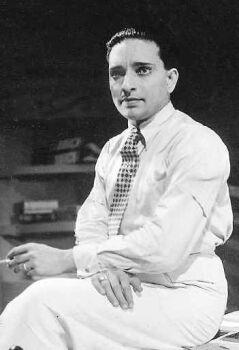
Y.V Rao PC: Unknown
Yaragudipati Varada Rao (born 1903) aka Y.V.Rao was a man of many parts that he was a filmmaker, actor and a film director. He was a visionary in his professional thinking & was a pioneer in making films in various Southern languages besides Hindi, right from silent movie era, when he started as an actor in silent films. Then he shifted to Madras in the 1920s & was cast as hero in many silent films like “Garuda Garva Bhangam”, “Gajendra Moksham” , and “Rose of Rajasthan”. Moving on, Y.V. Rao started his directorial debut with silent films, such as ‘Pandava Nirvana’ (1930), ‘Pandava Agnathavaas’ (1930) and ‘Hari Maya’ (1932).
Rao was at the pinnacle when he directed Tamil film, ‘Chintamani’ (1937) with MKT as its hero. The film created box-office records and proved to be a turning point in the annals of Tamil cinema and also in the life and career of Thyagaraja Bhagavathar.
Y.V.Rao married Actress Kumari Rukmini, through which they had a daughter, who would later come to be recognized as Actress Lakshmi.
Acharya
G. Raghavachari was a successful Madras High Court lawyer who was also active in the early Tamil Cinema writing and directing, without identifying himself for his work, as in those times cinema was a taboo in many minds, leaving Raghavachari to be anonymous in the movies he worked, including the popular film ‘Rishyasringar’ directed by him.
It was in 1943 at the insistence of movie mogul S. S. Vasan his name appeared as “Acharya” in the credit titles in Gemini’s ‘Mangamma Sabatham’.
During his days he was the most knowledgeable in South Indian Cinema and was involved in productions such as ‘Chandralekha’ (1948) & ‘Apoorva Sahotharargal’ (1949). As per Randor Guy, it was Raghavachari who directed the famous drum dance sequence in Chandralekha, using multiple cameras to film the sequence, though he walked out of the film in mid way.
T.R. Sundaram
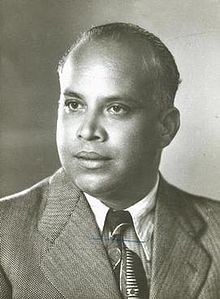
T.R.Sundaram PC: Unknown
T.R.Sundaram (born 1907) was from a wealthy family & was a graduate from Leeds University. He was married to a Britisher, Gladys while in UK.
Sundaram entered Tamil films in the early 1930s & was involved in film production in partnership. Later he promoted his own company “Modern Theatres” in Salem. He became a successful studio owner & directed “Sati Ahalya’ (1937). Some of the films made by Modern Theatres included ‘Arundathi’ (1943), ‘ Sulochana’ (1947), ‘Utthama Puthiran’ (1940), Manonmani’ (1942), ‘Aayiram Thalaivangi Apoorva Chintamani’ (1947), ‘Adithan Kanavu’ (1948), ‘Digambara Samiyar’ (1950), ‘Manthiri Kumari’ (1950), ‘Ponmudi’ (1950), ‘Valayaapathi’ (1952), ‘Sarvadhikari’ (1951), ‘Alibabavum Narpathu Thirudargalum’ (1956), and ‘Pasa Valai’ (1956). T.R.Sundaram was a great & strict disciplinarian at work.
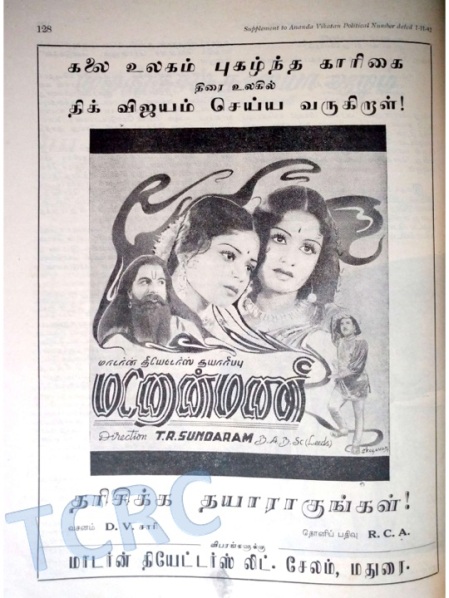
An ad of Manonmani in Ananda Vikatan Deepavali Malar 1942 PC: From the archives of TCRC
TRS gave breaks to many like M Karunanidhi & Kannadasan who became legends.Almost all the top stars have acted for Sundaram except the legend M. K. Thyagaraja Bhagavathar. Even the American filmmaker Ellis R. Dungan worked for him, directing ‘Manthiri Kumari,’ and ‘Ponmudi.’
Modern Theatres, one of the most successful film entities, has produced nearly two hundred movies in various languages. Out of this studio came out the first Malayalam movie, ‘Balan’. Besides, the first Tamil film in Gevacolor, ‘Alibabavum Narpathu Thirudargalum’ was also from Modern Theatres.
T.R. Sundaram who passed away in 1963.
K.Subramanyam
Subrahmanyam, a lawyer by profession, decided to go into movie making and founded in 1937 the Motion Pictures Producer Combines Studio where later Gemini Studios stood. He was a founding veteran of Tamil Film Industry & one of the founders of Nadigar Sangam in 1952.
He started his film career working on silent films directed by Raja Sandow. He started Meenakshi Cinetone, debuting his Directorial career with film Pavalakkodi, in which M. K. Thyagaraja Bhagavathar too debuted as an actor.
His remarkable movie was Balayogini, dealing with many social issues of the times. In 1938, he made Sevasadanam, advocating woman’s empowerment, Bhakta Cheta, on the subject of untouchability and “Mana Samrakshanam’, a war effort film. His best-known work was Kalki Krishnamurthy written nationalistic film Thyagaboomi, which got banned by the British government, for its explicit National flavor.
As to his personal life, he first married Meenakshi and later Actress S.D.Subbulakshmi. Through these two wed locks, he had children such as S. V. Ramanan, Dr Padma Subramanyam & Abaswaram Ramji, amongst others. His grandson S.Raghuram became a legendary dance choreographer in Indian film industry.
When Subramanyam’s studio was gutted in a major fire, the property came up for auction through a court order. At this juncture, Subrahmanyam persuaded S.S.Vasan to bid for it and enter film production. This is how Vasan’s Gemini Studios came into being.
Sriramulu Naidu
Sriramulu Naidu (born 1910 at Trichy) was another illustrious figure in the development of South Indian cinema. He was a great film personality who promoted as many as three motion picture studios in Coimbatore. In his younger days he was managing his railway retired father’s bakery in Coimbatore. It was the early thirties when Tamil films were made only in far off Calcutta, Bombay or Kolhapur as till around 1934 the South did not have facilities for movie making. When Premier Cinetone Studio opened in Coimbatore, Sreeramulu Naidu joined the Studio & got trained in several aspects of film msking. Later he co founded the famed Central Studios in Coimbatore, where ‘Tukaram’ was made in Tamil 1938, in which the famous Carnatic Musician Musiri Subramanya Iyer debuted I Cinema. In 1941 Sreeramulu Naidu at Central Studios made ‘Aryamala’. In this movie, Naidu introduced M.S.Sarojini as the heroine. (Later he married her too). In this film Naidu learnt he Art of film making from the other capable co-technicians. When a Madras-based Narayana Iyengar promoted Pakshiraja Films at Coimbatore, Sreeramulu Naidu joined him as his agent and eventually became its Partner. But he quit that and founded the legendary Pakshiraja Studios at Coimbatore, where once Kandhan Studios stood.
Naidu’s second film ‘Sivakavi’ (1943) with MKT in the lead was also a grand success. Raja Sandow initially directed this film but since he fell out with Naidu, the latter took over its direction.
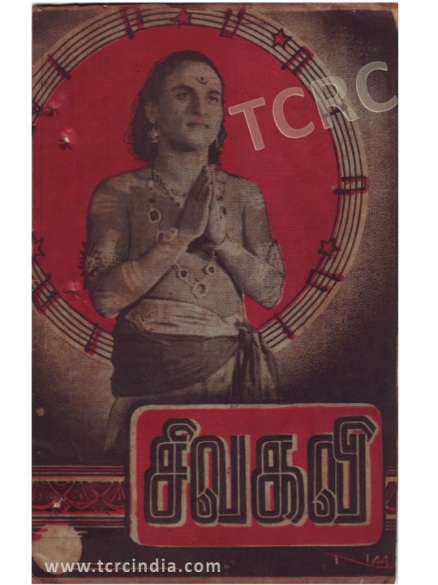
Song book of Sivakavi. PC: From the archives of TCRC
The other noted films under his direction included Pavalakodi, Kalyaniyin kanavan, Kanchana, Malaikallan & Maragatham ‘Malaikallan’ (1954) was made in various languages including Hindi. In Tamil version the pair was MGR- Bhanumathi & in Hindi the pair was Dilip Kumar-Meena Kumari.
If there was a Hall of Fame for the Film Industry in India, like it is in Hollywood, all the above illustrious as well as industrious men would have surely found their coveted places therein. The current Tamil Film Industry owe a lot to these relentless pioneers.

